“Food” in Japanese: The Ultimate Guide to Japanese Cuisine
Food in Japanese is 食べ物 (tabemono). Japan is well-known for its incredible cuisine, and Japanese food is an art form, with chefs spending years perfecting their craft.
And the food in Japan is unlike anything most Westerners have had before, with ingredients like octopus, natto, and roe (fish eggs).
But don’t let that intimidate you — Japanese food is an absolute treat. If you’re planning a trip to Japan, then you need to spend some time learning about the food and food culture.
Because not only is Japanese cuisine painstakingly created, there’s tons of unique etiquette. And some places won’t have an English menu, so it’s best to learn some food vocab and what’s-what so you can come hungry and prepared.
So in this article, we’ll do just that. You’ll learn about:
Table of contents
Japanese Food Vocabulary
Let’s start by learning with this Japanese food list of vocab. These Japanese food items will help you start building up your vocabulary to talk about Japanese food, find ingredients you need, and order at a restaurant.
Fruit and Veggies
- Apple: りんご (ringo)
- Banana: バナナ (banana)
- Strawberry: 苺 (ichigo) — it’s sometimes also ストロベリー (sutoroberi-)
- Plum: 梅 (ume)
- Peach: もも (momo)
- Cherry: さくらんぼ (sakuranbo)
- Pear: なし (nashi)
- Watermelon: スイカ (suika)
- Grapes: 葡萄 (budou)
- Fruit: 果物 (kudamono)
- Vegetables: 野菜 (yasai)
- Carrots: ニンジン (ninjin)
- Potato: じゃがいも (jagaimo)
- Beans: 豆 (mame)
- Corn: トウモロコシ (toumorokoshi)
- Cucumber: キュウリ (kyuuri)
- Garlic: ニンニク (ninniku)
- Onion: 玉ねぎ (tamanegi)
- Pumpkin: カボチャ (kabocha)
- Radish: 蕪 (kabu)
- Peppers: ピーマン (pi-man)
- Mushrooms: きのこ (kinoko)
Nuts, Grains, and Dairy Items
- Rice: 米 (kome), if uncooked; 飯 (meshi) or ご飯 (gohan) when cooked*
- Bread: パン (pan)
- Wheat: 麦 (mugi)
- Grains: 穀物 (kokumotsu)
- Walnuts: クルミ (kurumi)
- Almonds: アーモンド (a-mondo)
- Nuts: 木の実 (konomi)
- Sesame seeds: 胡麻 (goma)
- Dairy: 乳製品 (nyuuseihin)
- Milk: 牛乳 (gyuunyuu) or ミルク (miruku)
- Butter: バター (bata-)
- Yogurt: ヨーグルト (yo-guruto)
- Rice is such a staple of every meal in that when it’s cooked, it’s usually called ご飯 (gohan) or 飯 (meshi). These words are also used to say “meal” or “food” respectively.
Meat and Protein
- Meat: 肉 (niku)
- Beef: 牛肉 (gyuuniku)
- Chicken: 鶏肉 (toriniku) or just 鶏 (tori)
- Pork: 豚肉 (butaniku) or just 豚 (buta)
- Fish: 魚 (sakana)
- Shrimp: 海老 (ebi)
- Tuna: 鮪 (maguro)
- Eel: 鰻 (unagi)
- Eggs: 卵 (tamago)
- Tofu: 豆腐 (toufu)
Condiments and Ingredients
- Food: 食べ物 (tabemono)
- Ingredients: 食材 (shokuzai)
- Soy sauce: 醬油 (shouyu)
- Broth: 出汁 (dashi)*
- Rice wine vinegar: みりん (mirin)
- Salt: 塩 (shio)
- Pepper: 胡椒 (koshou) or ペッパー (peppa-)
- Sugar: 砂糖 (satou)
- Dashi is broth, but it’s different than your standard chicken or beef broth. Dashi is usually made with 昆布 (konbu, “kelp”), bonito flakes, shrimp, or sardines.
Drinks
- Drinks: 飲み物 (nomimono)
- Coffee: コーヒー (ko-hi-)
- Tea: 茶 (cha)
- Black tea: 紅茶 (koucha)
- Green tea: 緑茶 (ryokucha)
- Cola: コーラ (ko-ra)
- Water: 水 (mizu)
- Beer: ビール (bi-ru)
- Wine: ワイン (wain)
- Sake: お酒 (osake)
Japanese-Specific Foods
- Japanese citrus fruit: 柚子 (yuzu)
- Japanese melon: 夕張メロン (yuubari meron)
- Japanese sweet potato: さつまいも (satsumaimo)
- Quail eggs: うずらの卵 (uzura no tamago)
- Pollack roe: 明太子 (mentaiko)
- Sticky rice cakes: 餅 (mochi)
- Sweet red bean paste: あんこ (anko)
Famous Japanese Dishes You Must Try
Japanese cuisine is called 和食 (washoku), and there’s tons of famous Japanese food that you need to try when you go to Japan!
Of course, you’ll want to familiarize yourself with the Japanese food names and what they mean. That way you know what you’d like to order when exploring Japan or at your local Japanese restaurant.
So let’s talk about some traditional Japanese food.
Curry Rice: カレーライス
When you think of the national dish of Japan, you probably thought it’d be ramen or sushi. But actually, it’s curry rice!
カレーライス (kare-raisu) isn’t quite like Indian curry though. In fact, it’s more like a beef stew. It’s a popular homecooked meal made with meat and veggies in a thick gravy-like curry sauce and paired with rice.
Okonomiyaki: お好み焼き
お好み焼き (okonomiyaki) translates as “grilled how you like”. It’s a pancake mixed with whatever ingredients you’d enjoy.
Popular toppings are seafood, meat, veggies (especially cabbage), scallions, and cheese. But you can add anything you want to it. These ingredients are mixed into the batter and fried up.
There are a lot of okonomiyaki restaurants. Usually, you’ll cook the pancakes yourself with a grill at the center of the table.
Donburi: 丼
丼 (donburi) means “bowl”, specifically a bowl of rice that’s topped with food. There are many different variations of donburi, such as 牛丼 (gyuudon) with sliced meat in a soy sauce-based broth.
Another staple is 親子丼 (oyakodon) which literally means “parent and child bowl” — because it’s made with chicken and egg.
カツ丼 (katsudon) is another of the most popular variations, with tonkatsu, fried pork, in tsuyu broth. Tsuyu is a combo of bonito flakes, soy sauce, kombu, and sake or mirin.
Shabu Shabu: しゃぶしゃぶ
しゃぶしゃぶ (shabu shabu) is the Japanese onomatopoeia sound for swishing. This dish gets its name from swishing the meat around in the sauce.
Shabu shabu is a hotpot dish. Hotpot is super popular in Japan with many variations, like sukiyaki, but this is one of the most popular. It’s made by cooking each ingredient one by one at the table. Starting with meat that’s been dipped in ponzu sauce and dashi, and then adding veggies and tofu or cabbage last.
Ramen
It’s way more than the instant noodles you’re used to! Traditional ramen in Japan has a rich history and artistry to it, with the food carefully placed in each bowl.
Ramen in Japan often has different regional flavors, some with a salt-based broth, miso broth, tonkotsu pork broth, or a shouyu soy sauce broth.
The noodles are topped with different ingredients, such as slices of meat, nori (seaweed), a soft-boiled egg, onions, and veggies.
If you’re an anime fan, you’ve probably seen a little white and pink swirly shape in the ramen bowls. That’s called 鳴門巻き (narutomaki) or just ナルト (naruto). It’s a type of kamaboko, or fish surimi (fish paste).
Of course, it’s featured on the show Naruto all the time, but its name derives from the Naruto whirlpools between Awaji Island and Shikoku.
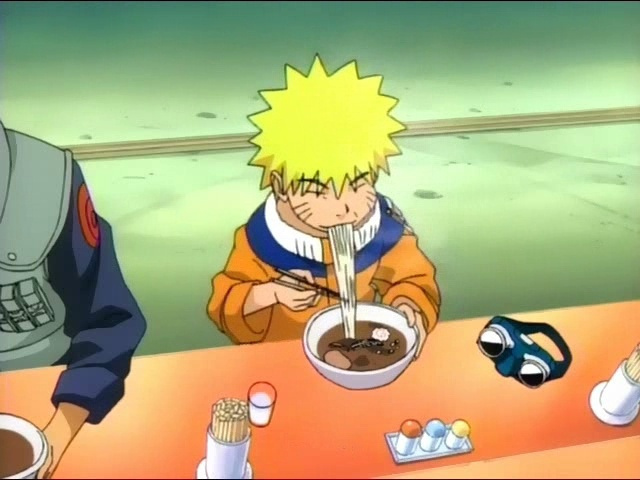
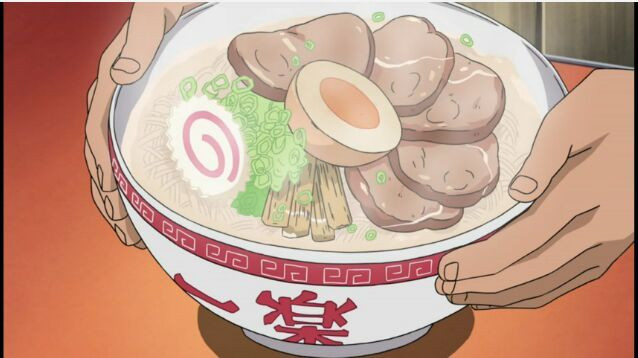
In text, you’ll often see it called “@” or with the emoji 🍥.
Natto: 納豆
納豆 (nattou) is probably the most love-it-or-hate-it food in Japan. There’s no middle ground with this traditional Japanese food. You either love natto or you’re repulsed by it.
Why such a strong reaction to soybeans? Because these soybeans are fermented, giving them a super strong smell and sticky, stringy, slimy texture. Some people say natto smells moldy, like old cheese or ammonia.
Yeah, it doesn’t sound too appetizing described like that. But natto has a powerful umami flavor that some people can’t get enough of.
Tamagoyaki: 卵焼き
卵焼き (tamagoyaki) means “fried egg”, but it’s way more than that. This is one of my very favorite Japanese dishes because it gives a whole new flavor to eggs that we don’t have in the West.
Tamagoyaki is a rolled egg omelet, made with dashi, shouyu, sugar, and sometimes nori.
You beat all the ingredients together, and then roll it in a frying pan in layers, being careful not to brown it. Once it’s done, you pat it dry with a paper towel and squeeze out excess moisture. Then you slice it up into rolls resembling sushi.
In fact, you’ve probably seen this before if you’re an anime or manga fan. This is a bento box staple!
Vegan and Vegetarian Japanese Food Options
It can be hard to figure out what you can eat in Japan or at a Japanese restaurant if you’re vegetarian or vegan. But there IS such a thing as vegetarian and vegan Japanese food!
There are different ways people eat vegetarian (although I know purists would argue that there isn’t). Some don’t eat meat or eggs, but eat dairy. Some eat eggs. Some don’t eat any animal products at all.
So, keeping that in mind, here’s a list of some options for vegetarian Japanese food and vegan food. Make it work for you!
One note here. The hardest part of eating vegetarian or vegan in Japan isn’t that there aren’t meat-free options, but that most foods are cooked with dashi. This broth base contains fish usually (but not always).
- Vegetable tempura is a delicious option for ovo-vegetarians. The batter usually contains eggs, however, and you’ll want to use soy sauce instead of the dipping sauce that comes with it (it contains fish).
- Mos Burger is a huge Japanese food chain — the healthy McDonald’s of Japan. They have vegetarian burgers.
- Dango are grilled rice balls on a stick served from Japanese street food stands. They have vegetarian options.
- Gyoza are potstickers, and they’re usually filled with meat. But you can often find vegan options filled with mushrooms, veggies, or tofu.
- Soba noodles are a vegan option, as long as you get plain soy sauce for dipping.
- Ramen and udon shops are starting to offer more vegetarian and vegan options throughout Japan, with vegetables and vegetable-based broth.
- Okonomiyaki can often be made vegetarian, as long as you’re okay with egg and milk in the batter.
- Onigiri is a Japanese rice ball snack wrapped in nori. The inside is usually stuffed, and some are vegan. So look for umeboshi (pickled plum), plain, or red bean filling.
- Sushi can be made vegetarian with pickled or fresh veggies or tofu.
- Kabocha korroke is a pumpkin croquette that is usually vegetarian.
These phrases will be helpful for you when navigating Japanese food in Japan as a vegetarian or vegan:
肉が食べられません。 Niku ga taberaremasen. “I can’t eat meat.”
畜産物を食べません。 Chikusanmono wo tabemasen. “I don’t eat animal products.”
ベジタリアンです。 Bejitarian desu. “I’m vegetarian.”
ビーガンです。 Bi-gan desu. “I’m vegan.”
_ なしでお願いします。 _ nashi de onegai shimasu. “Without _, please.”
Japanese Street Food Must-Haves
Hot Japanese food fresh off a street food stand is simply the best and a must-try if you’re visiting Japan. These stands are called 屋台 (yatai). They offer delicious, high-quality food at a very reasonable price.
Here are some popular Japanese foods to keep an eye out for to try:
- Takoyaki are fried little balls of batter and pieces of タコ (tako, “octopus”). It’s a Japanese staple!
- Yakitori are grilled chicken skewers that come in a variety of delicious seasonings and flavors.
- Yakiimo is a grilled sweet potato. In case you can’t tell, many foods include yaki (焼), which means it’s grilled.
- Kare Pan is a deep-fried bun filled with Japanese curry.
- Dorayaki is one you may have seen the popular character Doraemon eat often. These are sweet buns filled with red bean paste.
- Taiyaki is another popular one you may have seen in anime before. They’re fish-shaped cakes filled with custard usually, but can have a variety of fillings.
- Japanese crepes (クレープ, kure-pu) are to-die-for. Take a look at the amazing varieties and tell me your mouth isn’t watering. Japanese crepes are the best thing I’ve ever eaten in my life.
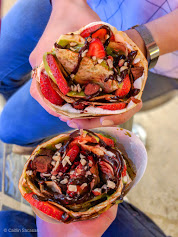

Sushi: Japanese Food Etiquette
You may think sushi is just sushi — but it’s far from it. In fact, sushi food is in its own category for etiquette.
Sushi dishes have quite a variety as well. Here are the common choices you have to choose from:
- Maki: This is what you probably think of when it comes to sushi. This is your rolls with rice, filling, and wrapped in seaweed.
- Sashimi: This is a cut of fish or shellfish with nothing else.
- Nigiri: This is a cut of fish or shellfish over rice (usually). But it can be any single topping over rice. For instance, A5 wagyu beef (the highest quality of beef in the world) is sometimes served nigiri-style.
- Uramaki: Rice on the outside, seaweed wrap on the inside holding the fillings together.
There are others as well, but these are the most “traditional” ones.
In Japan, 板前 (itaemae, chef) train for years as an apprentice before becoming a sushi chef. It’s an art form that’s taken very seriously, and as such, gets its own manners and rules around eating it.
Here are some rules to keep in mind:
- Don’t rub your chopsticks together, it’s considered rude.
- When not using your chopsticks, place them on your chopstick holder (called 箸置き, hashioki) or across your shouyu bowl.
- When picking up food off the communal plate or someone else’s plate, flip your chopsticks around. Use the wider end that hasn’t been in your mouth to grab the food.
- Don’t mix wasabi into your soy sauce.
- Don’t dip your sushi rice-first into your soy sauce. Dip the fish side in.
- It’s okay to eat nigiri or maki with your hands. But sashimi should only be eaten with chopsticks.
- Eat sushi in one bite. It’s not polite to take a bite out and have it fall apart.
- Don’t put ginger on your sushi. It’s a palate cleanser to use in between different sushi rolls.
- Sushi is not meant to be taken to-go.
- Don’t leave a messy plate, and don’t leave a bunch of soy sauce in your dish. It’s considered rude. Eat all your food and use what you need.
In general, keep in mind the itamae has worked many years to perfect the craft. Trust his or her judgement. Be mindful that the chef has taken care to make sure the sushi is well-balanced and rolled well. So you don’t want to tear apart the roll, add too many extra flavors, or leave food behind.
Japanese Food Culture – How to Be Polite in a Japanese Restaurant
Besides what we’ve already talked about, there are some other aspects of Japanese food culture that are helpful to know.
For example, you should never stick your chopsticks straight up in your rice or place them across your bowl or plate. You should only use the hashioki, the chopstick holder, when you’re not using them.
And you should never pass food from chopsticks to chopsticks. It’s similar to a ritual done when someone passes away, so it’s considered bad luck.
Slurping your ramen or udon noodles shows you find it delicious and isn’t considered rude. But make sure not to leave a mess! Japanese culture is all about cleanliness.
When something’s delicious, or someone’s made you food, it’s polite to express how delicious it is. You can say “美味しい!” (oishii) or “うまい!” (umai), which mean “delicious” or “great”.
When you’re done eating, set your napkin next to your plate and leave your plate empty. You don’t tip in Japan — and it’ll often confuse the servers if you try — so you don’t have to worry about that.
Lastly, it’s polite to say いただきます (itadakimasu) before a meal, which means something like “bon appetit.” When you’re done, you should say ごちそうさまでした (gochisousama deshita), which means “thanks for this meal.” You’ll say that to the sushi chef, the people who dined with you, the person who made the food, or who paid for it.
Itadakimasu! Enjoy Your Japanese Food!
You’re ready to go explore the delicious world of Japanese cuisine now. You won’t regret being a bit adventurous with your food choices and trying new things! Food in Japan is amazing.
Now that you’ve prepped for your foodie adventures, why not learn some other Japanese phrases for travel? Or if you plan to study abroad in Japan, learn about studying in a Japanese classroom and vocab you need to know.

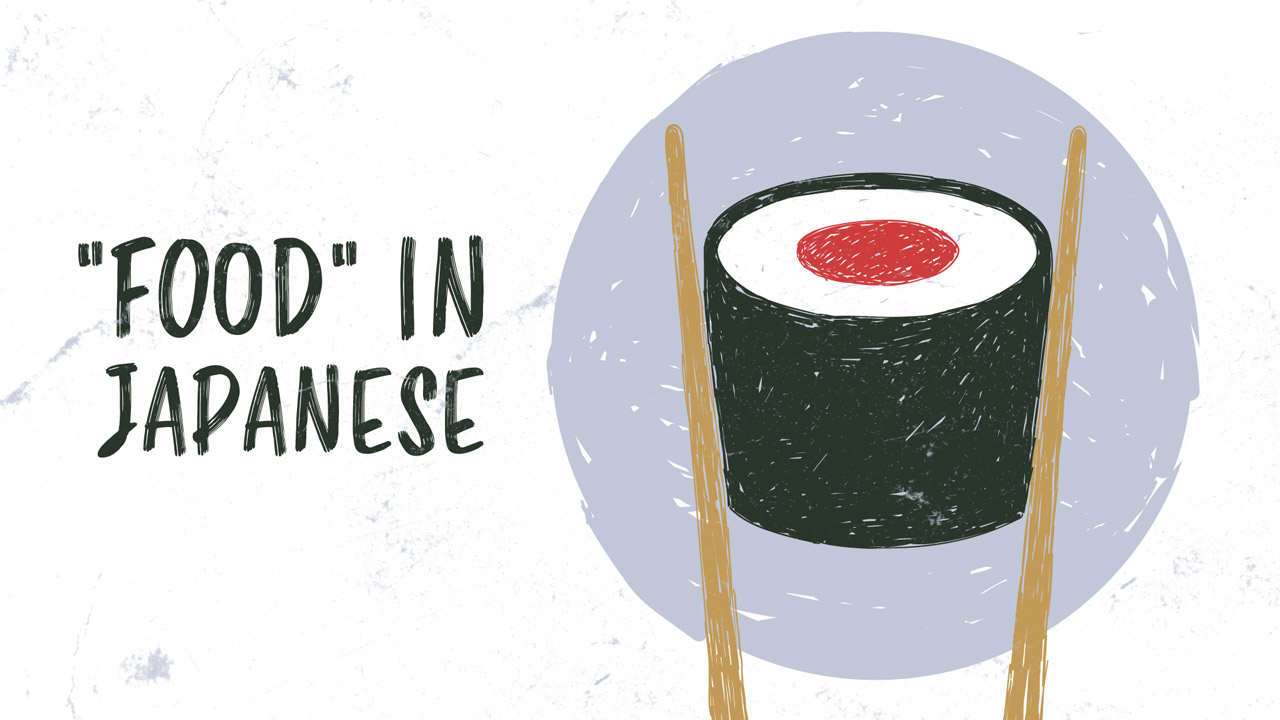
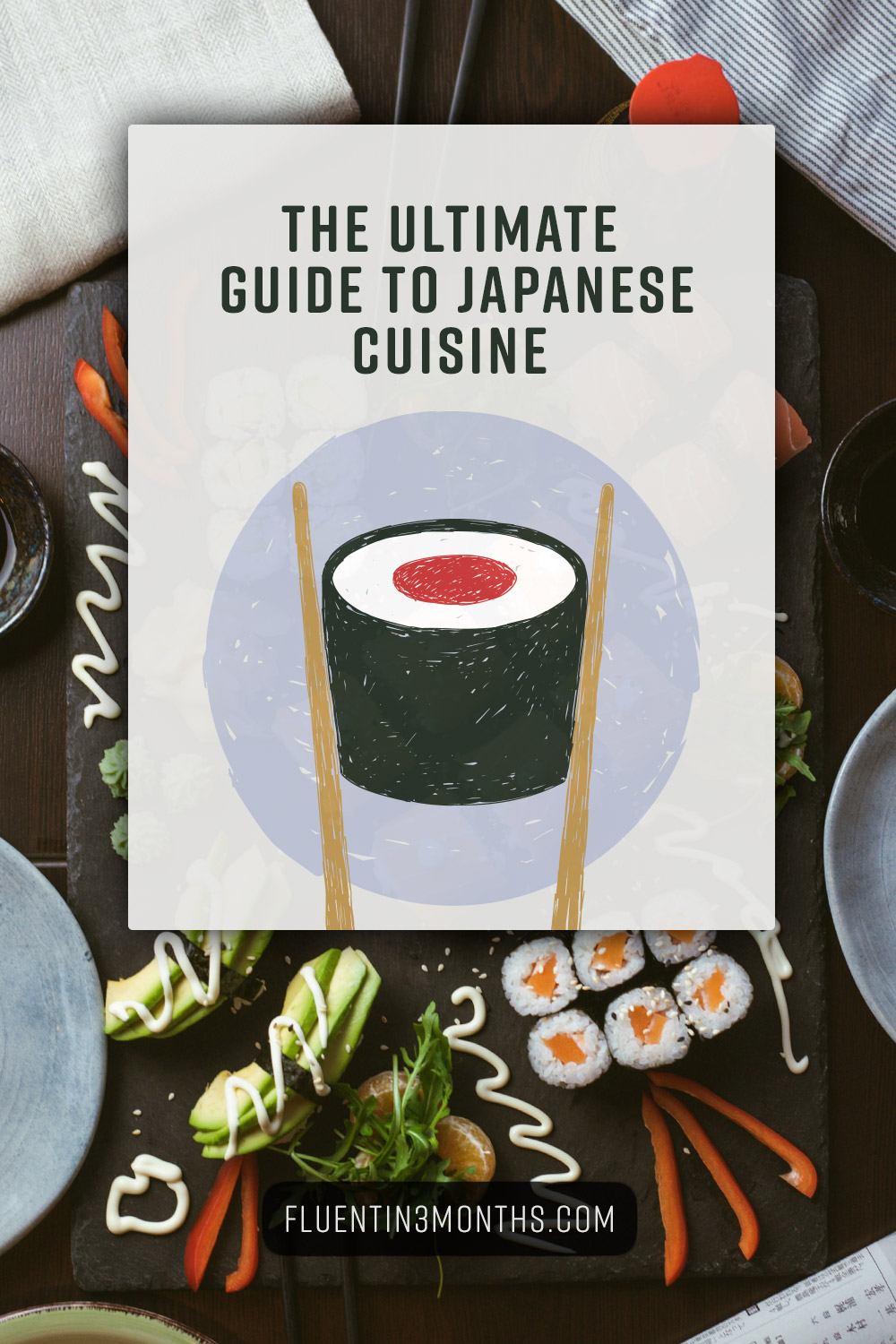

Social